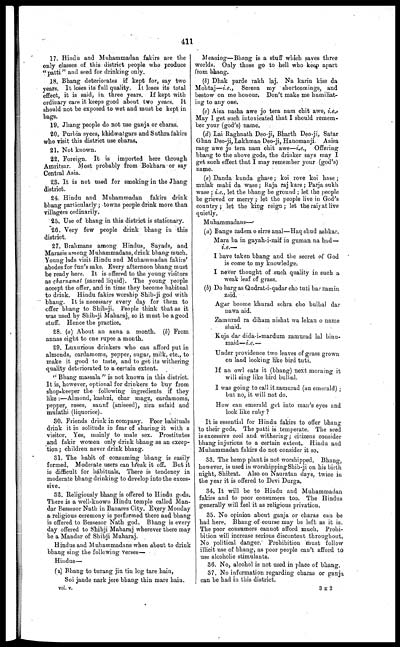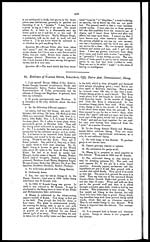Medicine - Drugs > Report of the Indian Hemp Drugs Commission, 1894-1895 > Volume V
(431) Page 411
Download files
Individual page:
Thumbnail gallery: Grid view | List view

411
17.Hindu and Muhammadan fakirs are the
only classes of this district people who produce
"patti" and seed for drinking only.
18.Bhang deteriorates if kept for, say two
years. It loses its full quality. It loses its total
effect, it is said, in three years. If kept with
ordinary care it keeps good about two years. It
should not be exposed to wet and must be kept in
bags.
19.Jhang people do not use ganja or charas.
20.Purbia syces, khidmatgars and Suthra fakirs
who visit this district use charas.
21.Not known.
22.Foreign. It is imported here through
Amritsar. Most probably from Bokhara or say
Central Asia.
23.It is not used for smoking in the Jhang
district.
24.Hindu and Muhammadan fakirs drink
bhang particularly; towns people drink more than
villagers ordinarily.
25.Use of bhang in this district is stationary.
26.Very few people drink bhang in this
district.
27.Brahmans among Hindus, Sayads, and
Marasis among Muhammadans, drink bhang much.
Young lads visit Hindu and Muhammadan fakirs'
abodes for fun's sake. Every afternoon bhang must
be ready here. It is offered to the young visitors
as charnamat (sacred liquid). The young people
accept the offer, and in time they become habitual
to drink. Hindu fakirs worship Shib-ji god with
bhang. It is necessary every day for them to
offer bhang to Shib-ji. People think that as it
was used by Shib-ji Maharaj, so it must be a good
stuff. Hence the practice.
28.(a) About an anna a month. (b) From
annas eight to one rupee a month.
29.Luxurious drinkers who can afford put in
almonds, cardamoms, pepper, sugar, milk, etc., to
make it good to taste, and to get its withering
quality deteriorated to a certain extent.
"Bhang massala" is not known in this district.
It is, however, optional for drinkers to buy from
shop-keeper the following ingredients if they
like:—Almond, kashni, char magz, cardamoms,
pepper, roses, saunf (aniseed), zira safaid and
mulathi (liquorice).
30.Friends drink in company. Poor habituals
drink it in solitude in fear of sharing it with a
visitor. Yes, mainly to male sex. Prostitutes
and fakir women only drink bhang as an excep-
tion; children never drink bhang.
31.The habit of consuming bhang is easily
formed. Moderate users can break it off. But it
is difficult for habituals. There is tendency in
moderate bhang drinking to develop into the exces-
sive.
32.Religiously bhang is offered to Hindu gods.
There is a well-known Hindu temple called Man-
dar Bessesor Nath in Banares City. Every Monday
a religious ceremony is performed there and bhang
is offered to Bessesor Nath god. Bhang is every
day offered to Shibji Maharaj wherever there may
be a Mandar of Shibji Maharaj.
Hindus and Muhammadans when about to drink
bhang sing the following verses-
Hindus—
(2)Bhang to turang jin tin log tare hain,
Soi jande nark jere bhang thin mare hain.
vol. v.
Meaning—Bhang is a stuff which 6aves three
worlds. Only those go to hell who keep apart
from bhang.
(b)Dhak parde rakh laj. Na karin kise da
Mohtaj—i.e., Screen my shortcomings, and
bestow on me honour. Don't make me humiliat-
ing to any one.
(c)Aisa nasha awe jo tera nam chit awe, i.e.,
May I get such intoxicated that I should remem-
ber your (god's) name.
(d)Lai Raghnath Deoji, Bharth Deo-ji, Satar
Ghan Deo-ji, Lakhman Deo-ji, Hanomanji. Aaisa
rang awe jo tera nam chit awe—i.e., Offering
bhang to the above gods, the drinker says may I
get such effect that I may remember your (god's)
name.
(e)Danda kunda ghase; koi rove koi hase;
mulak mahi da wase; Raja raj kare; Parja sukh
wase; i.e., let the bhang be ground; let the people
be grieved or merry; let the people live in God's
country; let the king reign; let the raiyat live
quietly.
Muhammadans—
(a)Bange zadem o sine anal—Haq shud ashkar.
Mara ba in gayah-i-zaif in guman na bud—
i.e.—
I have taken bhang and the secret of God
is come to my knowledge.
I never thought of such quality in such a
weak leaf of grass.
(b)Do barg as Qudrat-i-qadar cho tuti bar zamin
zaid.
Agar boome khurad sohra cho bulbal dar
nawa aid.
Zamurad ra diham nishat wa lekan o name
shaid.
Kuja dar dida-i-mardum zamurad lal binu-
maid—i.e.—
Under providence two leaves of grass grown
on land looking like bird tuti.
If an owl oats it (bhang) next morning it
will sing like bird bulbal.
I was going to call it zamurad (an emerald);
but no, it will not do.
How can emerald get into man's eyes and
look like ruby?
It is essential for Hindu fakirs to offer bhang
to their gods. The patti is temperate. The seed
is excessive cool and withering; citizens consider
bhang injurious to a certain extent. Hindu and
Muhammadan fakirs do not consider it so.
33.The hemp plant is not worshipped. Bhang,
however, is used in worshipping Shib-ji on his birth
night, Shibrat. Also on Nauratan days, twice in
the year it is offered to Devi Durga.
34.It will be to Hindu and Muhammadan
fakirs and to poor consumers too. The Hindus
generally will feel it as religious privation.
35.No opinion about ganja or charas can be
had here. Bhang of course may be left as it is.
The poor consumers cannot afford much. Prohi-
bition will increase serious discontent throughout.
No political danger. Prohibition must follow
illicit use of bhang, as poor people can't afford to
use alcoholic stimulants.
36.No, alcohol is not used in place of bhang.
37.No information regarding charas or ganja
can be had in this district.
vol v
3 K 2
Set display mode to: Large image | Zoom image | Transcription
Images and transcriptions on this page, including medium image downloads, may be used under the Creative Commons Attribution 4.0 International Licence unless otherwise stated. ![]()
| India Papers > Medicine - Drugs > Report of the Indian Hemp Drugs Commission, 1894-1895 > Volume V > (431) Page 411 |
|---|
| Permanent URL | https://digital.nls.uk/75122141 |
|---|
| Description | Volume 5: Evidence of witnesses from North-Western Provinces and Oudh and Punjab. Answers from witnesses in North-Western Provinces, Oudh and Punjab about cultivation and growth of hemp, preparation or manufacture, trade, consumption or use, effects, administration - taxation and control. |
|---|---|
| Attribution and copyright: |
|




